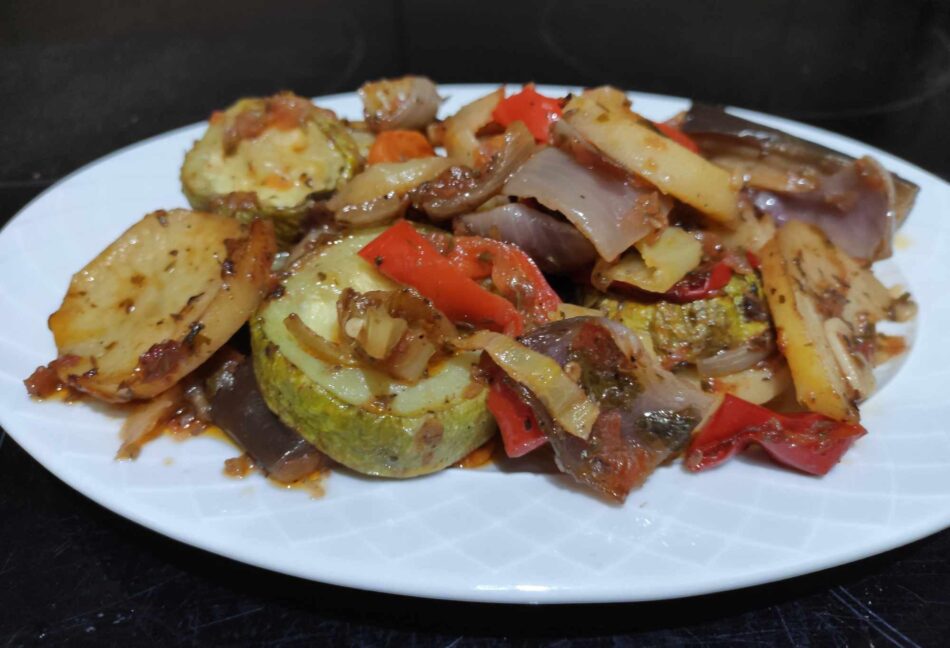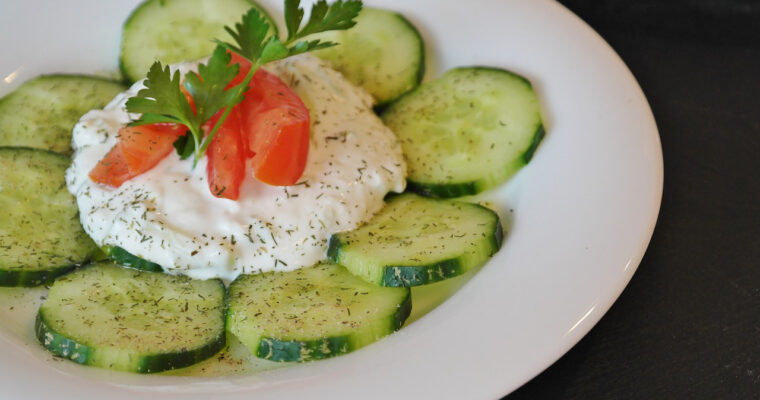What Is Briam?
Briam is a delicious and wholesome example of Greek cuisine’s emphasis on fresh ingredients, simplicity, and Mediterranean flavor. This traditional Greek roasted vegetable dish showcases the bounty of the Greek countryside and is both nutritious and satisfying. Greek Briam roasted vegetables can be enjoyed as a vegetarian main course or served as a flavorful side dish.
Mediterranean Cousins
Often called the Greek version of ratatouille, Briam shares similarities with French Ratatouille and Italian Giambotta. However, each bite of Briam brings something distinctly Greek to the table. The magic lies in its generous use of olive oil and its reliance on the sun-ripened vegetables of the Mediterranean.
A Bit of History on Briam
The word “Briam” is believed to have Turkish origins, likely derived from biryani, meaning “fried” or “sautéed.” This hints at the deep culinary exchange between Greece and its neighbors. Over centuries, this exchange shaped Greek cuisine into what we cherish today—bold, flavorful, and beautifully rustic.
Family Memories
Growing up, Briam was a staple in my grandmother’s summer kitchen. Every week, she would gather fresh vegetables from the garden or the local laiki agora (farmer’s market). We’d sit around the wooden table, slicing zucchini and eggplants, chatting about everything and nothing. She believed in cooking slowly, seasoning generously, and letting the oven do its work.
Briam – Ingredients & Method
Traditionally, Briam features zucchini, eggplant, potatoes, bell peppers, tomatoes, onions, and garlic. The vegetables are sliced or chopped, layered in a baking dish, and bathed in fruity Greek olive oil. Then come the herbs—oregano, thyme, parsley, and sometimes a bay leaf or two. These flavors gently mingle during baking.
Briam is slow-roasted at a moderate temperature until the vegetables become meltingly tender and slightly caramelized. The result? Greek Briam roasted vegetables are hearty, aromatic, and deeply satisfying. The tomatoes break down into a light sauce, the potatoes soak up the oil and spices, and everything tastes better the next day.
Serving Suggestions
Pair it with crusty bread and a crumble of feta cheese. Or serve it alongside grilled meat or fish. But honestly? It’s perfect all on its own. A drizzle of lemon juice on top just before serving brightens the whole dish.
Fun Fact: Part of the Ladera Tradition
Briam is part of the traditional ladera family of Greek dishes. Ladera means “in oil” and refers to vegetable dishes cooked exclusively with olive oil and no animal fat. Greek Briam roasted vegetables were popular during fasting periods in the Greek Orthodox calendar.
Tips for the Perfect Briam
- Use ripe, in-season vegetables for the best flavor.
- Don’t skimp on the olive oil—it’s essential!
- Cut vegetables evenly so they cook at the same rate.
- Cover with foil for the first half of baking, then uncover to allow browning.
- Let it rest after baking—flavors deepen as it cools.
Pro Tips & Variations
- Add sliced mushrooms or green beans for extra depth.
- Toss in a handful of rice or bulgur before baking for a heartier version.
- Sprinkle crumbled feta before serving for a tangy contrast.
- For a spicy kick, include a pinch of chili flakes or a chopped fresh chili.
- Want it richer? Add a spoonful of tomato paste to the sauce.
Modern Twist, Traditional Soul
In my kitchen, I keep the soul of the recipe but adapt it slightly. I roast the veggies on a large sheet pan in a single layer for extra caramelization. Then I transfer everything into a baking dish and let them finish cooking together with the juices. This way, you get both texture and that signature melt-in-your-mouth softness from Greek Briam roasted vegetables.
A Taste of Greek Summer
Briam is more than a recipe—it’s a ritual of simplicity and flavor. It’s what summer tastes like in Greece. Whether you’re a long-time fan or trying Greek Briam roasted vegetables for the first time, Briam welcomes you with warmth and color.
So next time you spot a basket of fresh vegetables, think of Greek Briam roasted vegetables. Chop, drizzle, season, and roast. Then sit back, take in the aroma, and enjoy a piece of Greek culinary tradition—one bite at a time.

Greek Briam (Traditional Roasted Vegetables)
Ingredients
- 2 potatoes
- 2 eggplants
- 2 carrots
- 2 zucchini
- 1 green bell pepper
- 1 red bell pepper
- 1 yellow bell pepper
- 2 onions
- 2 cloves garlic
- 400 grams fresh tomato
- 2 tbsp tomato paste
- 100 ml olive oil
- 3/4 cup water
- 1 tbsp` oregano
- 1 tbsp thyme
- 1 tsp honey
- salt and pepper to taste
Instructions
- Wash and cut all vegetables (except the tomato) into bite-sized pieces.
- Place into a bowl, set aside.
- Grate the tomato into another bowl. Add the tomato paste, olive oil, honey, oregano, thyme, salt and pepper and mix well by hand.
- Oil a baking dish and add the vegetables to the dish. Recommended size is 9 x 13 or 28cm x 35 cm.
- Pour the tomato mix over the vegetables and mix well.
- Add the 3/4 cup water (from the side of the pan, not over the vegetables) and cover the baking pan with aluminum foil.
- Ready to place into the oven preheated to 220 C or 380 F with air, for one hour. If the vegetable do not seem tender enough after this time, cook 10 minutes more.
- Serve with crusty bread and feta cheese.
Notes
🌟 Special Tips & Notes
- Seasonal Vegetables: Feel free to adapt Briam based on the vegetables that are in season. Adding zucchini, eggplant, tomatoes, and bell peppers is typical, but you can also include carrots, green beans, or even mushrooms.
- Olive Oil: Don’t skimp on the olive oil—it helps the vegetables cook evenly and adds a rich, Mediterranean flavor. Use a good quality extra virgin olive oil for the best results.
- Resting Time: After baking, let the Briam rest for a few minutes. This allows the flavors to develop further, making it even more delicious the next day.
- Vegan Variation: Briam is naturally vegan, but you can add crumbled feta cheese or a dollop of Greek yogurt for extra creaminess if desired.
- Serving Tip: Briam pairs wonderfully with crusty bread to soak up the flavorful olive oil and vegetable juices. It’s also great alongside grilled meat or seafood.
- Storage: Leftovers keep well in the fridge for up to 3 days, and the flavors often improve as they sit.




